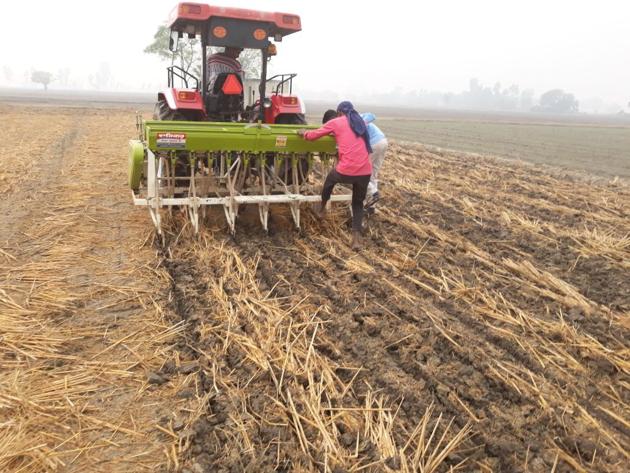Seeking ways to avoid stubble burning: These progressive Punjab farmers don’t play with fire
A PPCB executive engineer says the board receives over half-a-dozen calls from farmers every day, seeking tools to avoid stubble burning
Raj Mohan Singh, 40, cuts quite a towering figure with his flowing black beard. The progressive farmer from Bishanpur Chana village near Patiala, who’s bagged several awards for organic farming, has not been burning paddy stubble since the last season.

“Once I realised what it is doing to the air we breathe, and the soil on which we grow our crops, I stopped burning the stubble,” says Raj, who owns 20 acres.
He is among the handful of farmers in Patiala district who improvised the tools they owned to sow wheat without burning the paddy stubble.
Enterprising farmers
“I watered 10 acres extensively and then hired a rotavator, which mixed the straw with soil, before sowing wheat. On the remaining 10 acres, I used a zero drill that I already owned to sow wheat,” says Raj, telling you how he did not buy any of the machines that Punjab Agricultural University (PAU) officials have been espousing.
“They are expensive, besides I wanted to do something that other farmers could also follow,” says Raj, who claims 80% of farmers in the state own the zero drill, while 50% have the rotavator.
Gurbans Singh Punia, 70, a retired excise and taxation officer, whose family grows rice on 70 acres at Bibipur village, also refrained from burning the stubble this year. Punia says giving match stick the short shrift wasn’t much of a struggle on the 40 acres on which he’s sown the quick-growing PR 126 and PR 1509 varieties of rice.
“I harvested my crop in the last week of September and had over a month to prepare for wheat sowing.” Punia watered the fields for a month till the straw decomposed, and then ploughed it with a harrow. Like Raj, Punia takes pride in the fact that he didn’t buy any new equipment.
But he had some trouble on the 20 acres on which he had sown the late-growing PR 1121 variety of basmati. “I had no time to water and wait for the straw to disintegrate. On 10 acres, I used a normal cutter and then gave it to a factory, which made straw bales out of it. On the rest, I used a mulcher.”
Then, Punia sourced a “happy seeder” (a machine that helps sow wheat in the standing rice stubble) from the Punjab Pollution Control Board (PPCB) officials, who arranged it from the Mandauli village cooperative society.
PPCB executive engineer Surinder Singh Matharu says the board receives over half-a-dozen calls from farmers every day, seeking tools to avoid stubble burning.
“I use my influence to source them from cooperative societies. I have also tied up with the 12-MW biomass plant at Baghaura village in Mahilpur tehsil of Hoshiarpur, which consumes 400 tonnes of paddy bales a day,” says Matharu, who gets a high every time he sees a paddy field untouched by fire.
A village says no
The district agriculture department, meanwhile, concentrated its resources in the Kalar Majri village in Nabha, adopted by the state to implement the National Green Tribunal (NGT) guidelines. This year, not a single farmer in the village burnt their fields. “They provided us with happy seeders, mulchers and balers,” explains Bir Dalwinder Singh, who owns 40 acres in this village.
Singh says he stopped burning the stubble three years ago after learning about its harmful effects on the soil. In the last two years, he used a happy seeder provided by PAU to sow wheat. This year, he bought it.
Solution from the ground
Punia says the state government should equip village-level societies with implements to counter stubble burning instead of giving individual subsidies. “They can give youngsters these implements at interest-free loans, and the other villagers can use their services,” he said.
Most farmers say the incidence of burning would also peter off if the government bans slow-growing varieties such as PUSA 144, and promotes fast-growing breeds, which ripen at the end of September and give farmers a window of over a month to prepare their fields for wheat. Agreeing with them, Devinder Sharma, an agriculture analyst, says: “That’s what I call getting to the root of the problem.”



